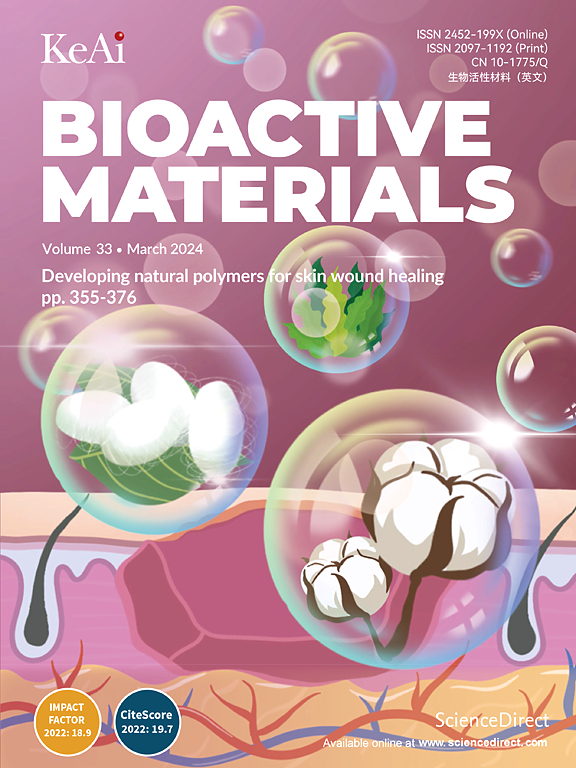生物聚合物止血海绵的智能设计:从止血到多功能。
IF 18
1区 医学
Q1 ENGINEERING, BIOMEDICAL
引用次数: 0
摘要
不受控制的出血仍然是临床和急诊护理中的主要死亡原因,对人的生命构成重大威胁。为了有效地控制出血,出现了许多止血材料。其中,天然来源的生物聚合物因其具有良好的内在生物相容性、生物降解性和生物活性而占有重要地位。此外,海绵由于血液吸收快,在临床和日常生活中得到了广泛的应用。因此,我们就生物聚合物止血海绵的最新进展和智能设计进行综述。从成分出发,系统介绍了多糖和多肽在止血中的应用,并对其独特的抗菌、抗氧化、免疫调节等生物活性进行了介绍。从海绵结构的角度来看,不同的制备工艺可以获得独特的物理性能和结构,这将影响材料的止血、抗菌和组织修复等性能。值得注意的是,作为发展前沿,总结了止血材料的多种功能,主要包括增强凝血、抗菌、避免肿瘤复发、促进组织修复、出血监测等。最后,强调了生物聚合物止血海绵发展面临的挑战,并提出了生物体内安全性、新兴材料、多应用场景和转化研究的未来方向。本文章由计算机程序翻译,如有差异,请以英文原文为准。

Smart design in biopolymer-based hemostatic sponges: From hemostasis to multiple functions
Uncontrolled hemorrhage remains the leading cause of death in clinical and emergency care, posing a major threat to human life. To achieve effective bleeding control, many hemostatic materials have emerged. Among them, nature-derived biopolymers occupy an important position due to the excellent inherent biocompatibility, biodegradability and bioactivity. Additionally, sponges have been widely used in clinical and daily life because of their rapid blood absorption. Therefore, we provide the overview focusing on the latest advances and smart designs of biopolymer-based hemostatic sponge. Starting from the component, the applications of polysaccharide and polypeptide in hemostasis are systematically introduced, and the unique bioactivities such as antibacterial, antioxidant and immunomodulation are also concerned. From the perspective of sponge structure, different preparation processes can obtain unique physical properties and structures, which will affect the material properties such as hemostasis, antibacterial and tissue repair. Notably, as development frontier, the multi-functions of hemostatic materials is summarized, mainly including enhanced coagulation, antibacterial, avoiding tumor recurrence, promoting tissue repair, and hemorrhage monitoring. Finally, the challenges facing the development of biopolymer-based hemostatic sponges are emphasized, and future directions for in vivo biosafety, emerging materials, multiple application scenarios and translational research are proposed.
求助全文
通过发布文献求助,成功后即可免费获取论文全文。
去求助
来源期刊

Bioactive Materials
Biochemistry, Genetics and Molecular Biology-Biotechnology
CiteScore
28.00
自引率
6.30%
发文量
436
审稿时长
20 days
期刊介绍:
Bioactive Materials is a peer-reviewed research publication that focuses on advancements in bioactive materials. The journal accepts research papers, reviews, and rapid communications in the field of next-generation biomaterials that interact with cells, tissues, and organs in various living organisms.
The primary goal of Bioactive Materials is to promote the science and engineering of biomaterials that exhibit adaptiveness to the biological environment. These materials are specifically designed to stimulate or direct appropriate cell and tissue responses or regulate interactions with microorganisms.
The journal covers a wide range of bioactive materials, including those that are engineered or designed in terms of their physical form (e.g. particulate, fiber), topology (e.g. porosity, surface roughness), or dimensions (ranging from macro to nano-scales). Contributions are sought from the following categories of bioactive materials:
Bioactive metals and alloys
Bioactive inorganics: ceramics, glasses, and carbon-based materials
Bioactive polymers and gels
Bioactive materials derived from natural sources
Bioactive composites
These materials find applications in human and veterinary medicine, such as implants, tissue engineering scaffolds, cell/drug/gene carriers, as well as imaging and sensing devices.
 求助内容:
求助内容: 应助结果提醒方式:
应助结果提醒方式:


